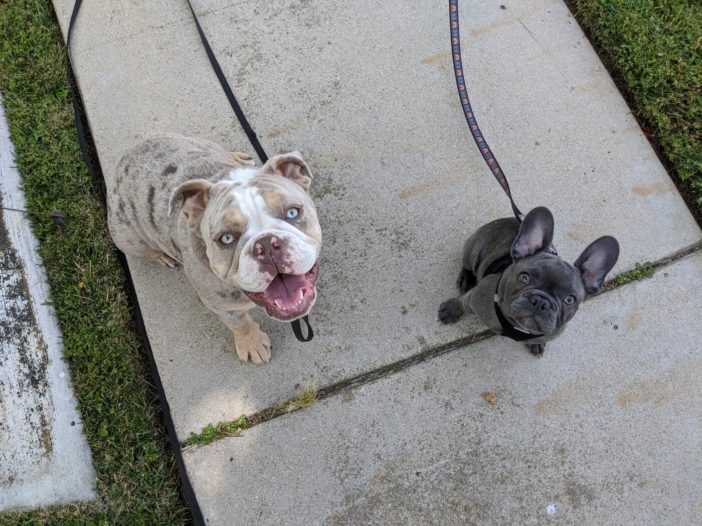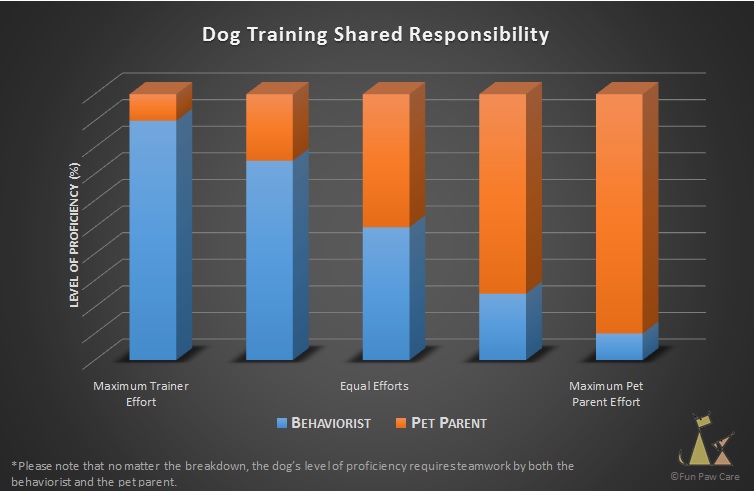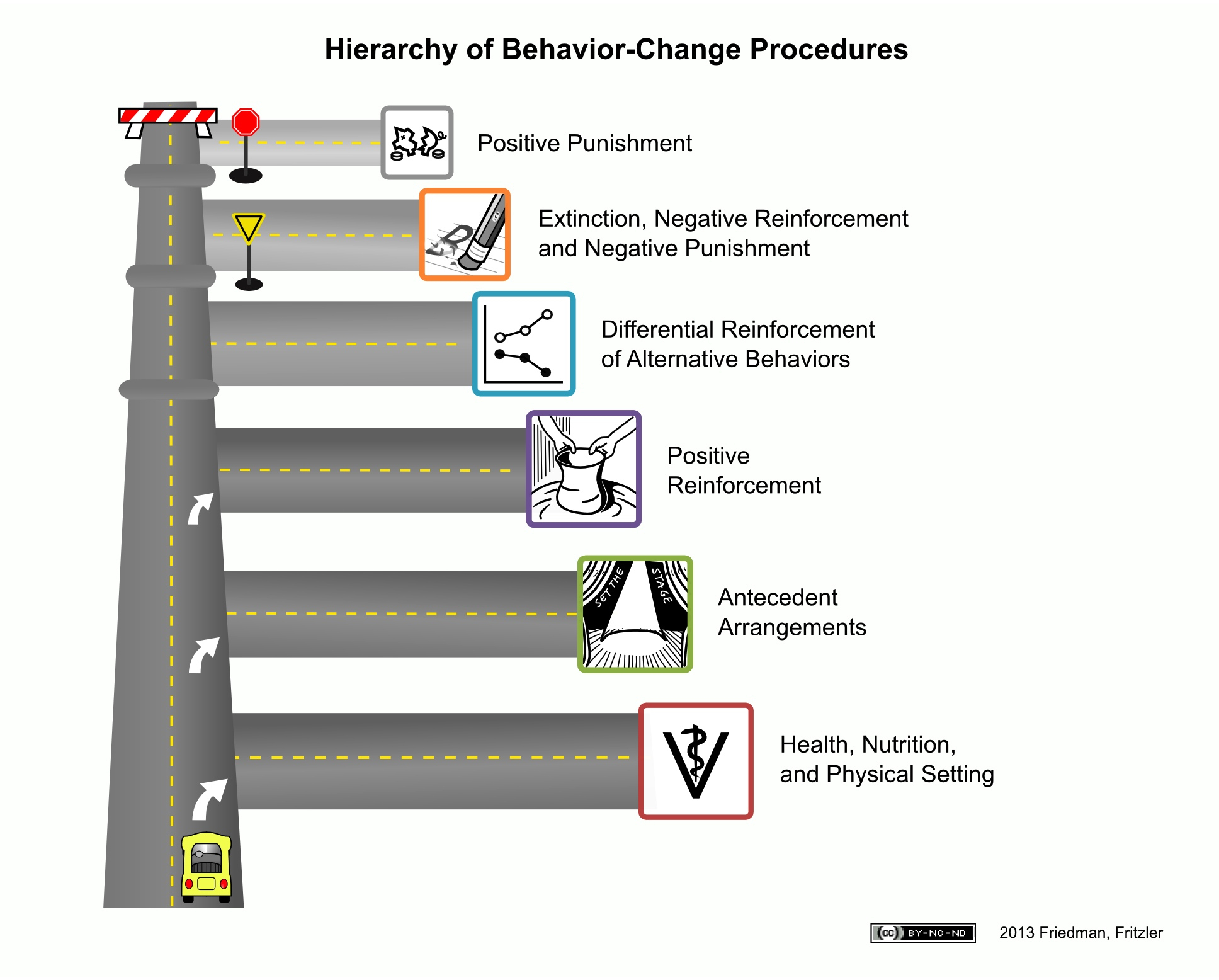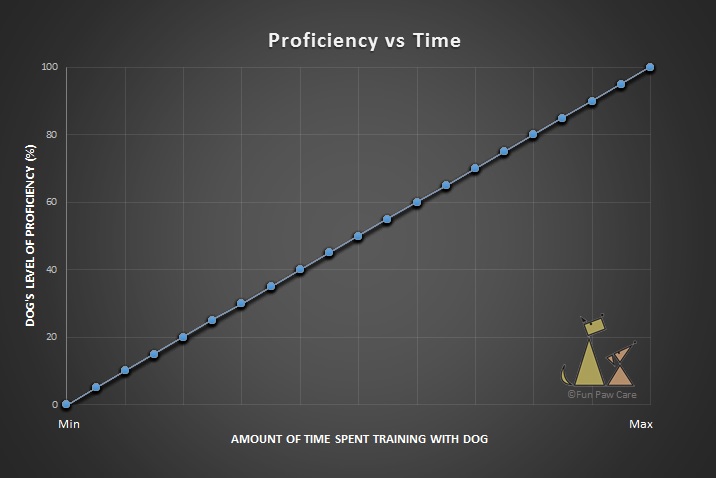
Dog Training Is Simple
(As long as you change)
(Updated 2020)
Do you want to change or do you want your dog to change when dog training? Los Angeles California families are often surprised to hear that they must change if they want their dog’s behavior to change. Even during our Los Angeles Dog Boot Camp, parents must still participate and understand why a behavior is occurring and what the ethologist, behaviorist, and/or trainer is articulating and putting forth in their behavior modification plan in order to set you up for success when your dog returns. The chart below shows the time relationship that a parent vs. a behaviorist must put into a dog’s training and behavior change.
To understand why this is true, imagine going to see a therapist because of relationship issues.
You walk into a psychologist’s office, seeking positive, healthy changes in your life because you’re discontent with specific circumstances and outcomes in your relationships. The psychologist speaks with you for a few sessions, gets to know you better, analyzes, your issues and experiences to get to the root of your suffering.
Weeks later, you are elated that your therapist now knows what the problem is, and has valuable information that will help you to “fix” the problem. The psychologist then provides a diagnosis and a treatment plan and the course of action you must take for you to be happier and to achieve the change you so desperately desire.
However, after hearing what the therapist has to say, you realize that his/her suggestions ask you to change your routines, schedules, actions, thoughts, environment, thought processes, responses, habits, etc.
If we are set in our ways, unwilling or uninterested in changing, how will anything be different? Most people want everyone else to change, but not me.
The above example is analogous to dog training and behavior modification. A fear-free Certified Dog Behavior Consultant (CDBC) and Certified Professional Dog Trainer (CPDT) is analogous to a therapist or psychologist for your dog or cat. However, your behaviorist is only with your dog for a very small amount of time in comparison to you, your family, and/or staff. So it is imperative that you and the people who interact with your puppy change, understand how to behave and what is needed to be done to create the change you are looking for in your dog.
A trainer can teach a dog new operant behaviors and tricks and work on desensitization and counterconditioning (D/CC) behavior modification techniques with you and your dog however if the pet parent does not practice these on a regular basis, communicating effectively with verbal and gestures with the three C’s in mind -clear, concise and consistent – the dog will soon regress or not learn what the trainer taught, modified or practiced.
This is why I mention many times to pet parents that dog training and behavior modification success and lasting results are contingent upon pet parents’ compliance and practice. If we want to change our dog’s behavior, we must change our behavior first.
How To Change A Dog’s Behavior
You change a dog’s behavior mostly through the antecedent arrangement (environmental changes). What some call avoidance, Certified Dog Behaviorists call management/managing the environment to set you and your dog up for success.
The Humane Hierarchy of Behavior Modification Intervention begins with the bare minimum, Least Intrusive Minimally Aversive (LIMA). There are problems with LIMA, but it is a valid starting point to change a dog’s behavior.
Health, nutrition, and medical checkup come first followed by the antecedent arrangement. If your dog trainer or behaviorist explains how to put on a choke chain, prong collar, or shock collar, you have encountered a fraud.
If they tell you how it’s important to walk out or doors first and be the leader of the pack mixed in with other nonsensical ideas such as you must eat first, sleep in the highest and best sleeping places and to make sure you show your dog who’s boss by dominating them, ask that person to leave your home immediately.
If your dog trainer or behaviorist tells you to “correct”/punish your dog by leash popping, poking the dog or physically manipulating your dog in any way, you have an uneducated layman on your hands and it would behoove you and your dog to continue your search for a qualified Certified Dog Training professional before more damage occurs.
Dog Training Applied Behavior Analysis (ABA)
ABA begins with a Functional Assessment (FA)
The ABC’s of a Functional Assessment is the smallest unit of breakdown to understand a behavior fully. Behaviors do not happen in a vacuum or out of the blue. Behaviors have meaning, a function, and serve a purpose for all animals. To change a dog’s target behavior, we must change the environment, the antecedent stimuli, and/or the consequences.
A. Antecedent – (2) Second, what is the antecedent? The antecedent is the trigger/s or stimuli that set the occasion for the behavior to occur. A thoughtful antecedent arrangement makes a preferred behavior more likely to occur. What are the distant antecedents? They predict the occurrence of a behavior but do not directly cue the behavior. What are the immediate antecedents? They immediately cue the behavior in question. The antecedent should be functionally related to the behavior.
B. Behavior – (1) First analyze and write down first what the dog’s behavior is, with no judgments, must be a verb, as are all behaviors. Not labels and hypothetical constructs and concepts such as my dog is dominant, aggressive, spoiled, or stubborn but operationally defined. We focus on overt, measurable behavior from the target learner whose behavior we would like to change.
C. Consequence – (3) Third, what is the consequence of the behavior being analyzed? The events, stimuli, or conditions that occur immediately after a behavior are the consequences of that behavior. The consequence outcome will increase or decrease the strength or frequency of the immediately preceding behavior.
A Dog’s Behavior Change = Antecedent Arrangement + Consequences
If you want a dog’s (or any animal’s) behavior to change we must change the antecedent stimuli, environment, triggers, and consequences. The A and C of the ABC Functional Assessment represent 2/3rds of the whole. Consequently, 2/3rds of the change you desire in your dog occurs when you change.
Since it is typically the pet parents that provide the consequences and the environment, it is imperative for the parents to change before we teach the dog alternative behaviors. Thus we focus on the parent and dog’s environment and consequences prior to moving on to obedience, desensitization and counterconditioning, and other training.
As the renowned Bob Baily sagely mentioned, “It is more important not to allow or to reinforce undesirable behavior than it is to forget to reward desirable behavior.”
Dog training and behavior modification are simple but not easy! It is not easy because people are reluctant to change, dogs are not. Dog’s do not fight or oppose change if the consequences are different.
For change to occur, people have to be open-minded, listen, follow instructions, open to coaching/learning, and be malleable, just like their dogs. If a person is resistant to change so will their dogs, and consequently, their pup’s behavior will not improve greatly.
Dog training and behavior modification involve both animals at either end of the leash but relies mostly on the willingness of the pet parents to be involved and to change. The only thing constant in life is change, don’t be afraid, you can do it!




Leave a Reply